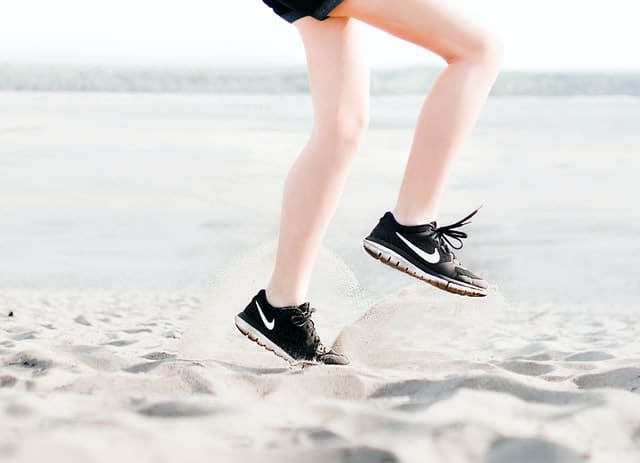The runners often face shin splints. It is also famous for the tibial stress syndrome. They use terms to describe pain in the front position of their lower leg and alongside the portion.
If you are a runner, then you may also face this issue. Want to learn more about running form to prevent shin splints? Well, we have got you!
It doesn’t always start from the bad and treat you too fast. The shin splints are quick and become worse in a short time. Usually, runners face shin splints during too much stress and their muscles in an additional workout.
Suppose you change your workout routine and start doing high-energy exercises like jumping, running, and other training programs. So different reasons cause the shin splints.
If you are also facing this issue, this article is for you. Here we will share the common reasons and symptoms of shin splints and the practical ways to prevent them.
So let’s dive into it. Also, you must check the shin splints stretches before running.
What are shin splints?

The shin splints or the medial tibial stress syndrome is a medical term that is common in runners. You can also say the injury in the leg muscle of runners.
Shin splints are an overuse injury in the leg’s shin region due to the repetitive impact of strains on shin muscles and tissues. The shin splints have frequent stresses that exceed the usual body capacity to recover from tissue or muscle damage.
The initial stage of shin splint pain, leading to severe conditions like fractures. It is an injury that can be recovered according to personal history. So when the runners repeatedly run after having the shin splint, it can cause greater pain and sometime stress fractures as well
Causes of shin splints
Now it’s clear that shin splints are common in runners. But as we already mentioned, some other issues cause injury in the lower leg.
Here are some common running injury causes of shin splints or medial tibial stress fracture syndrome.
Tight calf muscles
The tight calf muscles are a common cause of shin splints. The soft tissues in the tibial region are the suspects. Keep in mind that the calf muscles and smaller ankle muscles have a strong attachment with the tibia regions.
They have possible injuries due to tight calf muscles. The structure is too deep but has solid fibrous tissue enclosing the muscles and organs at the origin of the syndrome.
Weak calf muscles
Yes, weak calf muscles are also a common cause of shin splints. The little or decreased strength of the calf causes the shin splint.
Many theories support that the tissue bone of the tibia is involved in pain after stress and load during running.
Overload on tibia region
Again the tibia region has shin splints due to stress and overloading. Many studies show that shin splints appear through the microtrauma on the bone during a long-running track, bending, bowing of the tibia region.
Tibial bending/bowing
It is one of the famous causes of shin splints. When there is an increased load on the narrow structure of the tibial, then it is displaced from the place.
The bending moments of the structure lower the cross-sectional area, especially in the narrowest part. This part of the tibia is the distal third portion, where the shin splint appears.
Practice following the smooth running and workout routines to prevent tibial bending.
How do runners prevent shin splints?
Runners can prevent themselves from shin splints. It is essential to take precautionary measures before facing major fractures or injuries. So here, we will share some necessary preventive measures that help prevent runners from shin splints.
So if you are a regular runner, follow these tips and protect your shin area.
Build Up Gradually
Build up your running capacity slowly. If you are a new runner, don’t run more than 5 miles a day. It helps to protect your shin muscles and tissues from stress.
Treat your muscles slowly and gradually increase the speed and area to run. Moreover, don’t break the period of everyday running. In short, build your intensity and directions slowly from minutes to hours.
You will simultaneously feel the development in your capacities.
Mix It Up
Mix your running with other cross-training. It helps you to reduce the stress on body parts. When you only run and don’t change the position, it causes severe pressure on the shin area.
Supplement your miles with other less intense exercises like cycling, swimming, and more. According to experts, when you run and mix it with the cross-training sessions, you will have more power and benefits to health.
Avoid Heel Strike
It is one of the common mistakes that also cause shin splints. It would help if you fought with the tendency of heel strikes. If you hit the heel first, it will cause shin splints.
It leads your foot to slap down onto the pavement stretch your shin muscles. You also need to work hard and slow down the speed. Moreover, when you run on your toes, it causes stress to the calf muscles in the shin area. Try to prevent shin splints by running flat or mid-footed.
In addition, if you work out and perform rope jumping, then it’s not a great effort initially. Strengthen your calves and then start improving your foot strikes.
Keep a Short Stride
It’s essential to keep the short stride and not pull yourself to the finish line. Make a habit of watching fast running lengths and then exceeding the workout routine.
Start it from slow practice if you come back to the sport after a week or two. You can reduce your shin splints liability and gradually increase from small miles to large.
Set your running goals and start slowly achieving them. Keep in mind that there is no magic number to start and end the workout routines. You can add short intervals to your workout routine and lead towards your goals.
Replace your old sneakers with a supportive running shoe
Replace your old sneakers with supportive running shoes. As we already said, don’t run barefoot or with tight or itchy shoes. It helps to minimize the itchiness and heartiness.
Usually, athletes face the issue of shin splints due to their wrong shoe selection. Always choose stable shoes that offer great comfort during running.
Moreover, when shopping for sneakers, you experience comfort and proper fitting.
Running barefoot causes shin splints. Experts advise you to change the shoes when it leads to the warranty time. Replace your shoes after every 300 miles and select comfortable shoes.
Reduce Running
It is the best way to prevent shin splints. Reduce your running frequency and distance and build your career slowly. If you face an issue in your shin, cut out the length.
You can also use icing and massaging to face the calf in muscles for 20 minutes. It helps to reduce the stress and irritation in your shin area.
Train your muscles gently after running a few miles for some days and then increasing the time or frequency. It allows your shin to teach and heal slowly. Set your aim to run a few miles every day and gradually increase the distance.
Moreover, you can also combine running with walking tracks to break your muscles. In general, maintain your muscles, let the shin experience stress, and relax frequently.
Diagnose the Pain
Your body acts like a working machine. Pay continuous attention to your body. If you have the classic shin splint, it covers your leg’s frontal area. The traditional shin splint will not last long for a long time and have a less degenerative effect. When you start running, then it will come and go with time. However, the acute pain at one spot is severe and leads to stress fractures.
You can’t run with the sharp pain unless it gets treated with effective therapies.
Insert an Orthotic
If you face the heel striking or overpronation, replace your shoes or foam liner with the professional plastic orthotic. It helps to give better arch support and offers an extraordinary running experience.
Moreover, it helps prevent shin splints and other injuries in the knees, legs, and feet. You can get orthotic padding from local stores and superstores.
In addition, you can also consult with your doctor and ask for the protection of your ankles to prevent shin splints.
Also check best Nike running shoes for shin splints for a better idea of best running shoes.
Conclusion
Now you have a compelling guide regarding running form to prevent shin splints. If you are a runner, then you may face the shin splits condition that harms your shin bone area health instead of benefiting you.
It is easy to train your body tissues and muscles for running and extreme workouts.
Ensure that you know about your body conditions and their painting reasons. Some of us have regular stiffness that doesn’t last long after a few times or muscle relaxing. However, if the pain lasts longer than the usual time, it will be shin splints.
In that case, you need to follow the preventive measures for your health. It helps you train your body according to a regular workout routine and get more benefits from running and workout.
Continue working from small miles and then start achieving the goals. It helps you to attain outstanding results.































